Customer Value Management: CLV Analysis and Strategies for Homebase
VerifiedAdded on 2020/10/22
|12
|3906
|218
Report
AI Summary
This report delves into Customer Value Management (CVM), focusing on Customer Lifetime Value (CLV) within the context of a UK-based retail business, Homebase. The report explores the components and calculation of CLV, emphasizing its benefits in customer segmentation, early warning signs, time-saving, brand loyalty, and sales increase. It also examines factors influencing CLV, such as customer spending levels, cross-buying behavior, and transaction frequency. Furthermore, the report applies CLV principles and data collation within an organizational context, demonstrating the successful implementation of promotional campaigns. Finally, the report analyzes different market segmentation strategies and techniques to increase customer relationships and loyalty. The report concludes with an evaluation of the key concepts of CLV management within an organizational context.
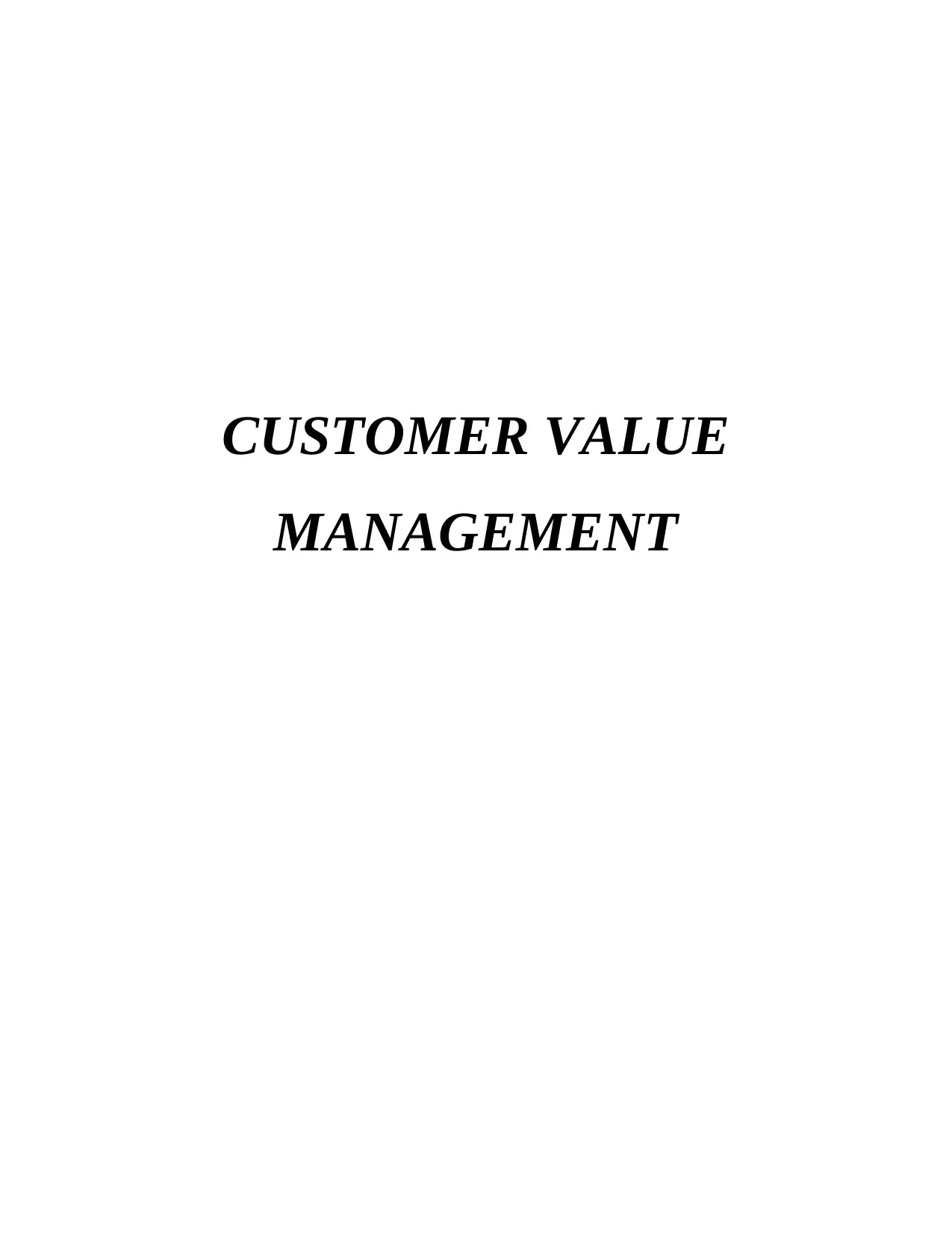
CUSTOMER VALUE
MANAGEMENT
MANAGEMENT
Paraphrase This Document
Need a fresh take? Get an instant paraphrase of this document with our AI Paraphraser
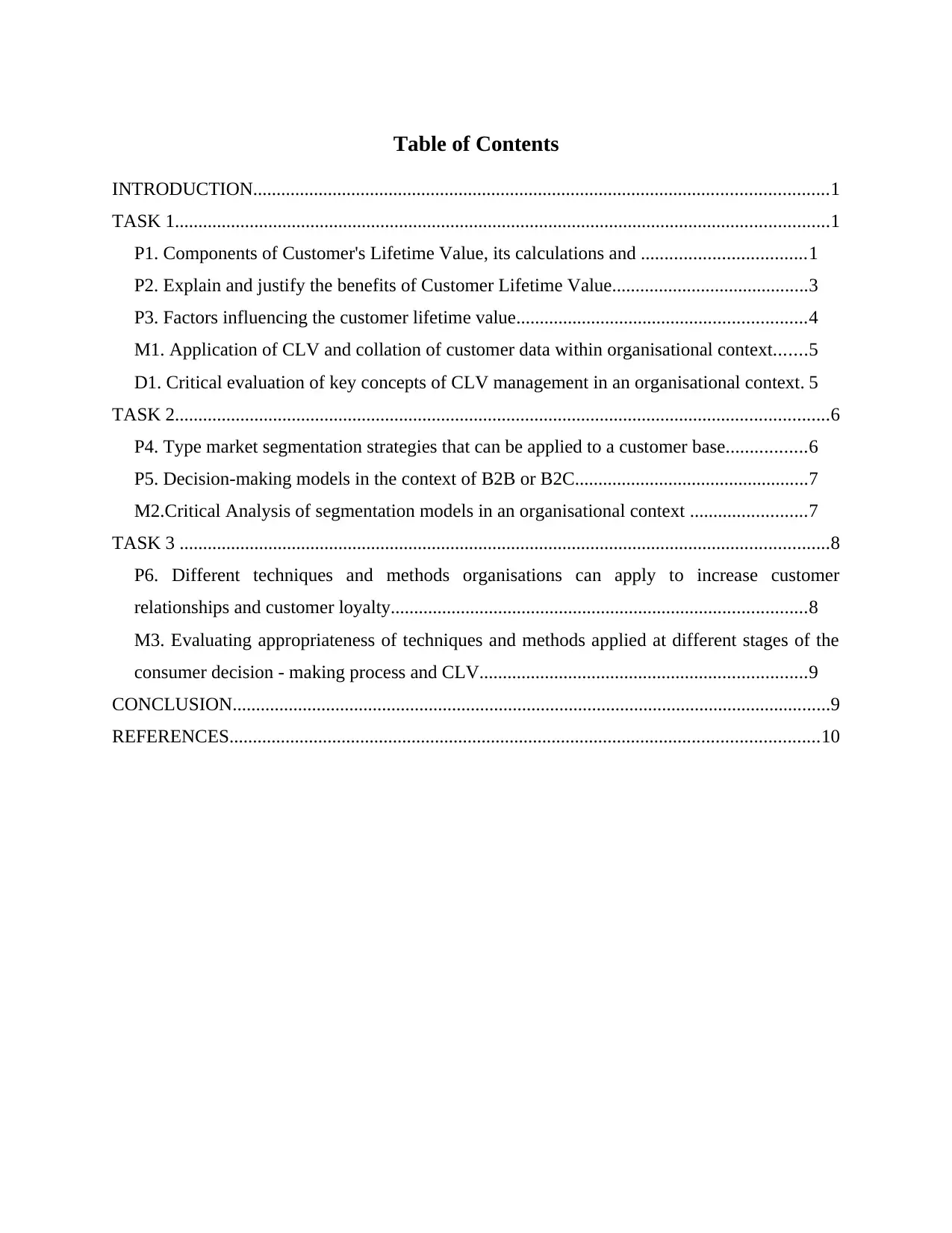
Table of Contents
INTRODUCTION...........................................................................................................................1
TASK 1............................................................................................................................................1
P1. Components of Customer's Lifetime Value, its calculations and ...................................1
P2. Explain and justify the benefits of Customer Lifetime Value..........................................3
P3. Factors influencing the customer lifetime value..............................................................4
M1. Application of CLV and collation of customer data within organisational context.......5
D1. Critical evaluation of key concepts of CLV management in an organisational context. 5
TASK 2............................................................................................................................................6
P4. Type market segmentation strategies that can be applied to a customer base.................6
P5. Decision-making models in the context of B2B or B2C..................................................7
M2.Critical Analysis of segmentation models in an organisational context .........................7
TASK 3 ...........................................................................................................................................8
P6. Different techniques and methods organisations can apply to increase customer
relationships and customer loyalty.........................................................................................8
M3. Evaluating appropriateness of techniques and methods applied at different stages of the
consumer decision - making process and CLV......................................................................9
CONCLUSION................................................................................................................................9
REFERENCES..............................................................................................................................10
INTRODUCTION...........................................................................................................................1
TASK 1............................................................................................................................................1
P1. Components of Customer's Lifetime Value, its calculations and ...................................1
P2. Explain and justify the benefits of Customer Lifetime Value..........................................3
P3. Factors influencing the customer lifetime value..............................................................4
M1. Application of CLV and collation of customer data within organisational context.......5
D1. Critical evaluation of key concepts of CLV management in an organisational context. 5
TASK 2............................................................................................................................................6
P4. Type market segmentation strategies that can be applied to a customer base.................6
P5. Decision-making models in the context of B2B or B2C..................................................7
M2.Critical Analysis of segmentation models in an organisational context .........................7
TASK 3 ...........................................................................................................................................8
P6. Different techniques and methods organisations can apply to increase customer
relationships and customer loyalty.........................................................................................8
M3. Evaluating appropriateness of techniques and methods applied at different stages of the
consumer decision - making process and CLV......................................................................9
CONCLUSION................................................................................................................................9
REFERENCES..............................................................................................................................10
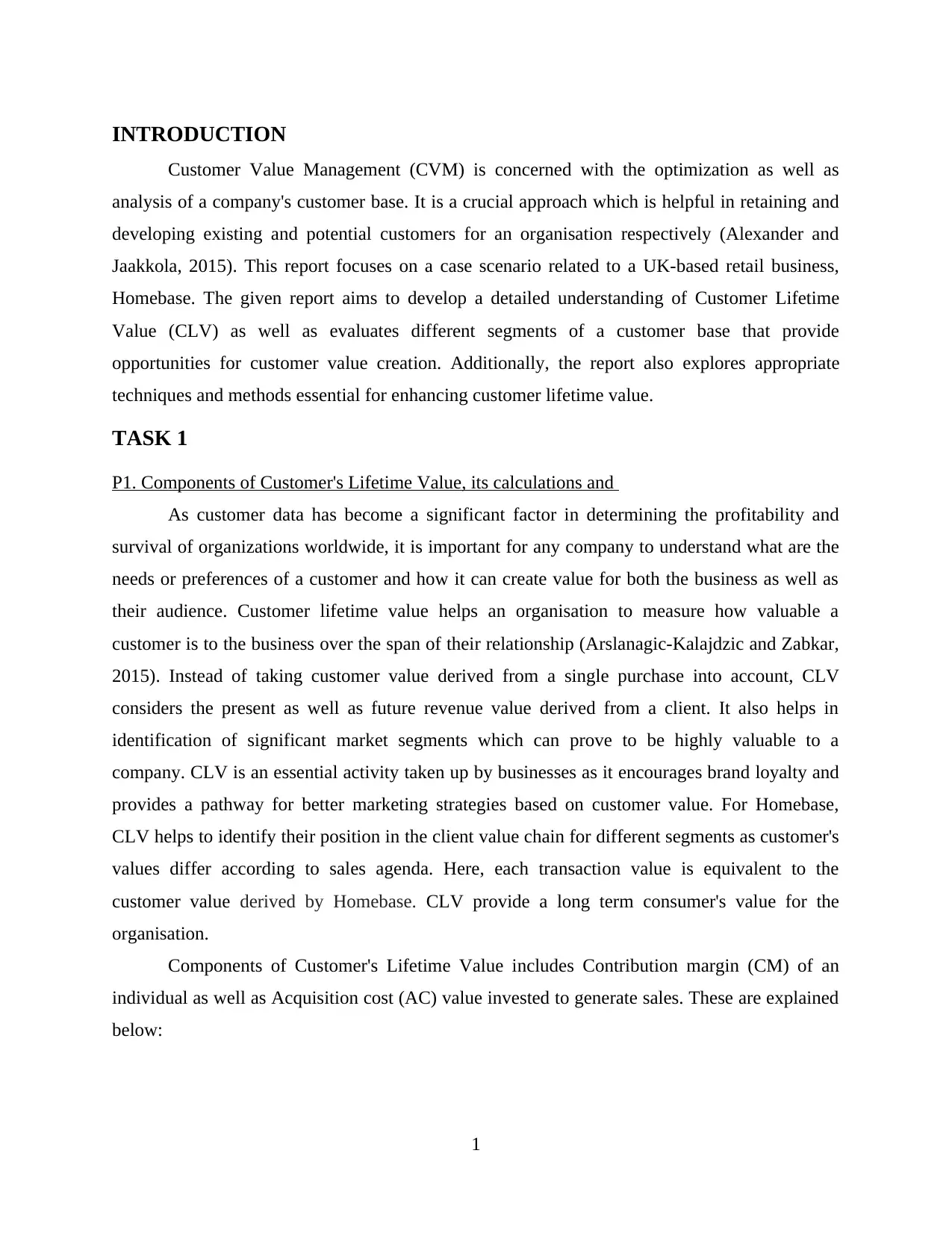
INTRODUCTION
Customer Value Management (CVM) is concerned with the optimization as well as
analysis of a company's customer base. It is a crucial approach which is helpful in retaining and
developing existing and potential customers for an organisation respectively (Alexander and
Jaakkola, 2015). This report focuses on a case scenario related to a UK-based retail business,
Homebase. The given report aims to develop a detailed understanding of Customer Lifetime
Value (CLV) as well as evaluates different segments of a customer base that provide
opportunities for customer value creation. Additionally, the report also explores appropriate
techniques and methods essential for enhancing customer lifetime value.
TASK 1
P1. Components of Customer's Lifetime Value, its calculations and
As customer data has become a significant factor in determining the profitability and
survival of organizations worldwide, it is important for any company to understand what are the
needs or preferences of a customer and how it can create value for both the business as well as
their audience. Customer lifetime value helps an organisation to measure how valuable a
customer is to the business over the span of their relationship (Arslanagic-Kalajdzic and Zabkar,
2015). Instead of taking customer value derived from a single purchase into account, CLV
considers the present as well as future revenue value derived from a client. It also helps in
identification of significant market segments which can prove to be highly valuable to a
company. CLV is an essential activity taken up by businesses as it encourages brand loyalty and
provides a pathway for better marketing strategies based on customer value. For Homebase,
CLV helps to identify their position in the client value chain for different segments as customer's
values differ according to sales agenda. Here, each transaction value is equivalent to the
customer value derived by Homebase. CLV provide a long term consumer's value for the
organisation.
Components of Customer's Lifetime Value includes Contribution margin (CM) of an
individual as well as Acquisition cost (AC) value invested to generate sales. These are explained
below:
1
Customer Value Management (CVM) is concerned with the optimization as well as
analysis of a company's customer base. It is a crucial approach which is helpful in retaining and
developing existing and potential customers for an organisation respectively (Alexander and
Jaakkola, 2015). This report focuses on a case scenario related to a UK-based retail business,
Homebase. The given report aims to develop a detailed understanding of Customer Lifetime
Value (CLV) as well as evaluates different segments of a customer base that provide
opportunities for customer value creation. Additionally, the report also explores appropriate
techniques and methods essential for enhancing customer lifetime value.
TASK 1
P1. Components of Customer's Lifetime Value, its calculations and
As customer data has become a significant factor in determining the profitability and
survival of organizations worldwide, it is important for any company to understand what are the
needs or preferences of a customer and how it can create value for both the business as well as
their audience. Customer lifetime value helps an organisation to measure how valuable a
customer is to the business over the span of their relationship (Arslanagic-Kalajdzic and Zabkar,
2015). Instead of taking customer value derived from a single purchase into account, CLV
considers the present as well as future revenue value derived from a client. It also helps in
identification of significant market segments which can prove to be highly valuable to a
company. CLV is an essential activity taken up by businesses as it encourages brand loyalty and
provides a pathway for better marketing strategies based on customer value. For Homebase,
CLV helps to identify their position in the client value chain for different segments as customer's
values differ according to sales agenda. Here, each transaction value is equivalent to the
customer value derived by Homebase. CLV provide a long term consumer's value for the
organisation.
Components of Customer's Lifetime Value includes Contribution margin (CM) of an
individual as well as Acquisition cost (AC) value invested to generate sales. These are explained
below:
1
⊘ This is a preview!⊘
Do you want full access?
Subscribe today to unlock all pages.

Trusted by 1+ million students worldwide
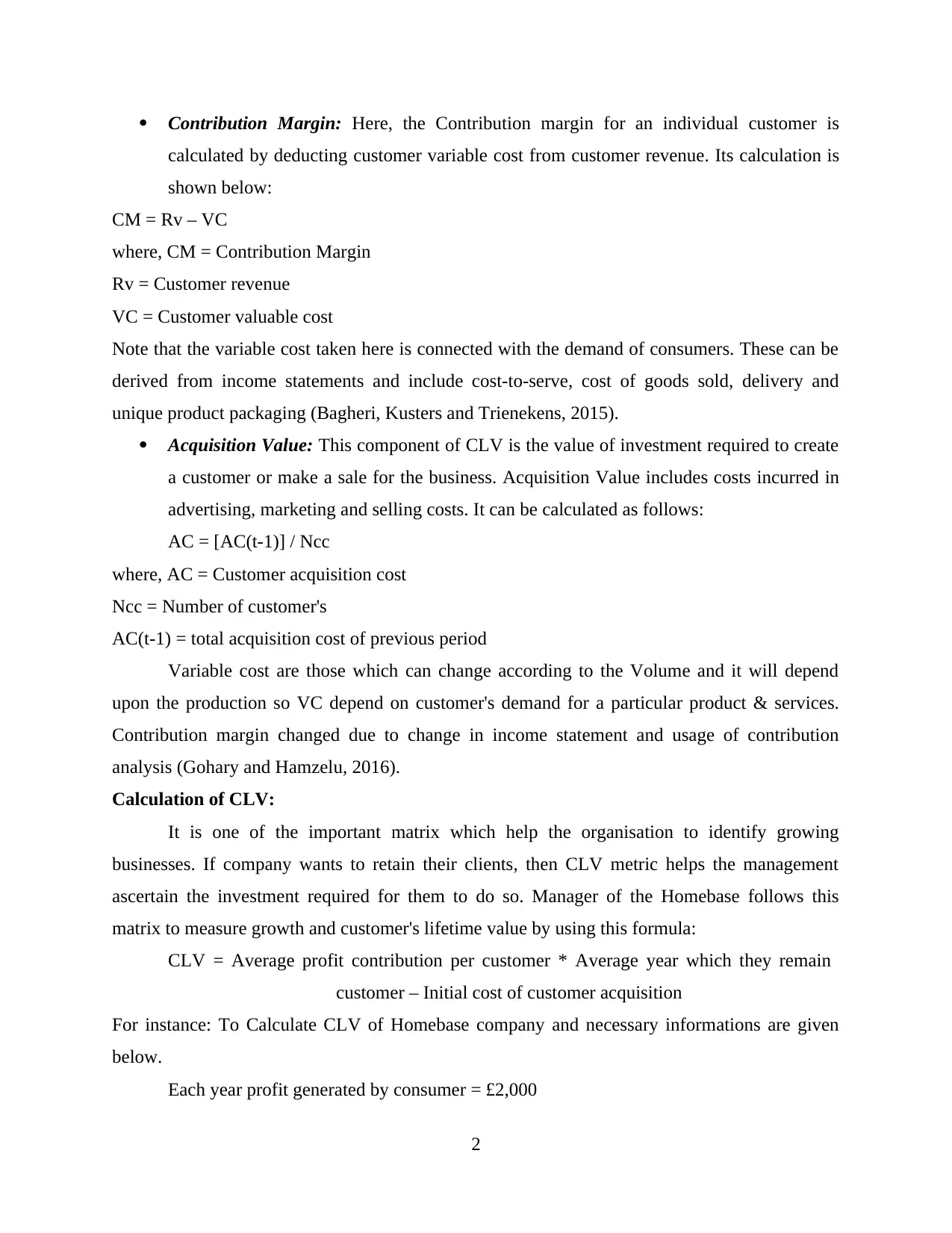
Contribution Margin: Here, the Contribution margin for an individual customer is
calculated by deducting customer variable cost from customer revenue. Its calculation is
shown below:
CM = Rv – VC
where, CM = Contribution Margin
Rv = Customer revenue
VC = Customer valuable cost
Note that the variable cost taken here is connected with the demand of consumers. These can be
derived from income statements and include cost-to-serve, cost of goods sold, delivery and
unique product packaging (Bagheri, Kusters and Trienekens, 2015).
Acquisition Value: This component of CLV is the value of investment required to create
a customer or make a sale for the business. Acquisition Value includes costs incurred in
advertising, marketing and selling costs. It can be calculated as follows:
AC = [AC(t-1)] / Ncc
where, AC = Customer acquisition cost
Ncc = Number of customer's
AC(t-1) = total acquisition cost of previous period
Variable cost are those which can change according to the Volume and it will depend
upon the production so VC depend on customer's demand for a particular product & services.
Contribution margin changed due to change in income statement and usage of contribution
analysis (Gohary and Hamzelu, 2016).
Calculation of CLV:
It is one of the important matrix which help the organisation to identify growing
businesses. If company wants to retain their clients, then CLV metric helps the management
ascertain the investment required for them to do so. Manager of the Homebase follows this
matrix to measure growth and customer's lifetime value by using this formula:
CLV = Average profit contribution per customer * Average year which they remain
customer – Initial cost of customer acquisition
For instance: To Calculate CLV of Homebase company and necessary informations are given
below.
Each year profit generated by consumer = £2,000
2
calculated by deducting customer variable cost from customer revenue. Its calculation is
shown below:
CM = Rv – VC
where, CM = Contribution Margin
Rv = Customer revenue
VC = Customer valuable cost
Note that the variable cost taken here is connected with the demand of consumers. These can be
derived from income statements and include cost-to-serve, cost of goods sold, delivery and
unique product packaging (Bagheri, Kusters and Trienekens, 2015).
Acquisition Value: This component of CLV is the value of investment required to create
a customer or make a sale for the business. Acquisition Value includes costs incurred in
advertising, marketing and selling costs. It can be calculated as follows:
AC = [AC(t-1)] / Ncc
where, AC = Customer acquisition cost
Ncc = Number of customer's
AC(t-1) = total acquisition cost of previous period
Variable cost are those which can change according to the Volume and it will depend
upon the production so VC depend on customer's demand for a particular product & services.
Contribution margin changed due to change in income statement and usage of contribution
analysis (Gohary and Hamzelu, 2016).
Calculation of CLV:
It is one of the important matrix which help the organisation to identify growing
businesses. If company wants to retain their clients, then CLV metric helps the management
ascertain the investment required for them to do so. Manager of the Homebase follows this
matrix to measure growth and customer's lifetime value by using this formula:
CLV = Average profit contribution per customer * Average year which they remain
customer – Initial cost of customer acquisition
For instance: To Calculate CLV of Homebase company and necessary informations are given
below.
Each year profit generated by consumer = £2,000
2
Paraphrase This Document
Need a fresh take? Get an instant paraphrase of this document with our AI Paraphraser
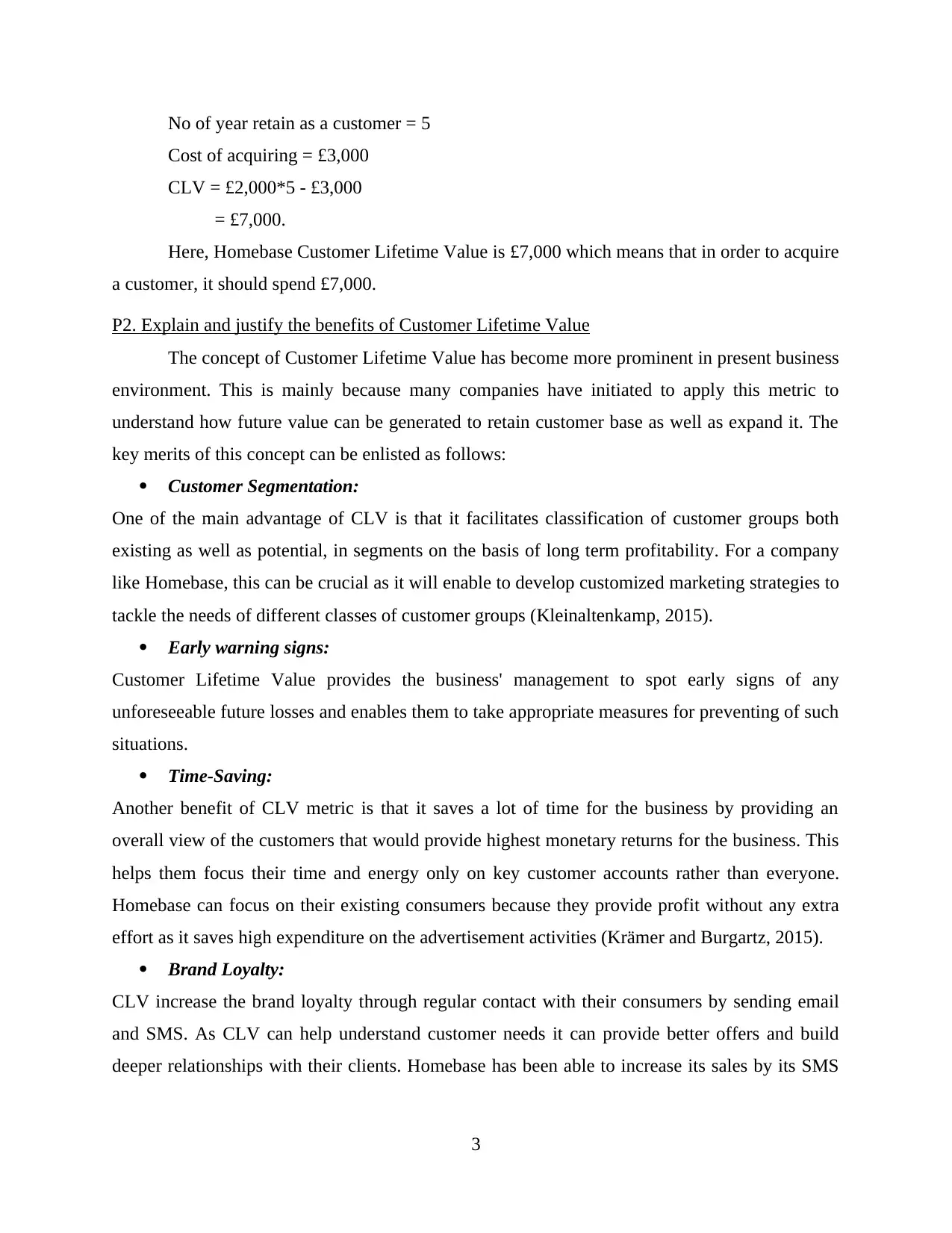
No of year retain as a customer = 5
Cost of acquiring = £3,000
CLV = £2,000*5 - £3,000
= £7,000.
Here, Homebase Customer Lifetime Value is £7,000 which means that in order to acquire
a customer, it should spend £7,000.
P2. Explain and justify the benefits of Customer Lifetime Value
The concept of Customer Lifetime Value has become more prominent in present business
environment. This is mainly because many companies have initiated to apply this metric to
understand how future value can be generated to retain customer base as well as expand it. The
key merits of this concept can be enlisted as follows:
Customer Segmentation:
One of the main advantage of CLV is that it facilitates classification of customer groups both
existing as well as potential, in segments on the basis of long term profitability. For a company
like Homebase, this can be crucial as it will enable to develop customized marketing strategies to
tackle the needs of different classes of customer groups (Kleinaltenkamp, 2015).
Early warning signs:
Customer Lifetime Value provides the business' management to spot early signs of any
unforeseeable future losses and enables them to take appropriate measures for preventing of such
situations.
Time-Saving:
Another benefit of CLV metric is that it saves a lot of time for the business by providing an
overall view of the customers that would provide highest monetary returns for the business. This
helps them focus their time and energy only on key customer accounts rather than everyone.
Homebase can focus on their existing consumers because they provide profit without any extra
effort as it saves high expenditure on the advertisement activities (Krämer and Burgartz, 2015).
Brand Loyalty:
CLV increase the brand loyalty through regular contact with their consumers by sending email
and SMS. As CLV can help understand customer needs it can provide better offers and build
deeper relationships with their clients. Homebase has been able to increase its sales by its SMS
3
Cost of acquiring = £3,000
CLV = £2,000*5 - £3,000
= £7,000.
Here, Homebase Customer Lifetime Value is £7,000 which means that in order to acquire
a customer, it should spend £7,000.
P2. Explain and justify the benefits of Customer Lifetime Value
The concept of Customer Lifetime Value has become more prominent in present business
environment. This is mainly because many companies have initiated to apply this metric to
understand how future value can be generated to retain customer base as well as expand it. The
key merits of this concept can be enlisted as follows:
Customer Segmentation:
One of the main advantage of CLV is that it facilitates classification of customer groups both
existing as well as potential, in segments on the basis of long term profitability. For a company
like Homebase, this can be crucial as it will enable to develop customized marketing strategies to
tackle the needs of different classes of customer groups (Kleinaltenkamp, 2015).
Early warning signs:
Customer Lifetime Value provides the business' management to spot early signs of any
unforeseeable future losses and enables them to take appropriate measures for preventing of such
situations.
Time-Saving:
Another benefit of CLV metric is that it saves a lot of time for the business by providing an
overall view of the customers that would provide highest monetary returns for the business. This
helps them focus their time and energy only on key customer accounts rather than everyone.
Homebase can focus on their existing consumers because they provide profit without any extra
effort as it saves high expenditure on the advertisement activities (Krämer and Burgartz, 2015).
Brand Loyalty:
CLV increase the brand loyalty through regular contact with their consumers by sending email
and SMS. As CLV can help understand customer needs it can provide better offers and build
deeper relationships with their clients. Homebase has been able to increase its sales by its SMS
3
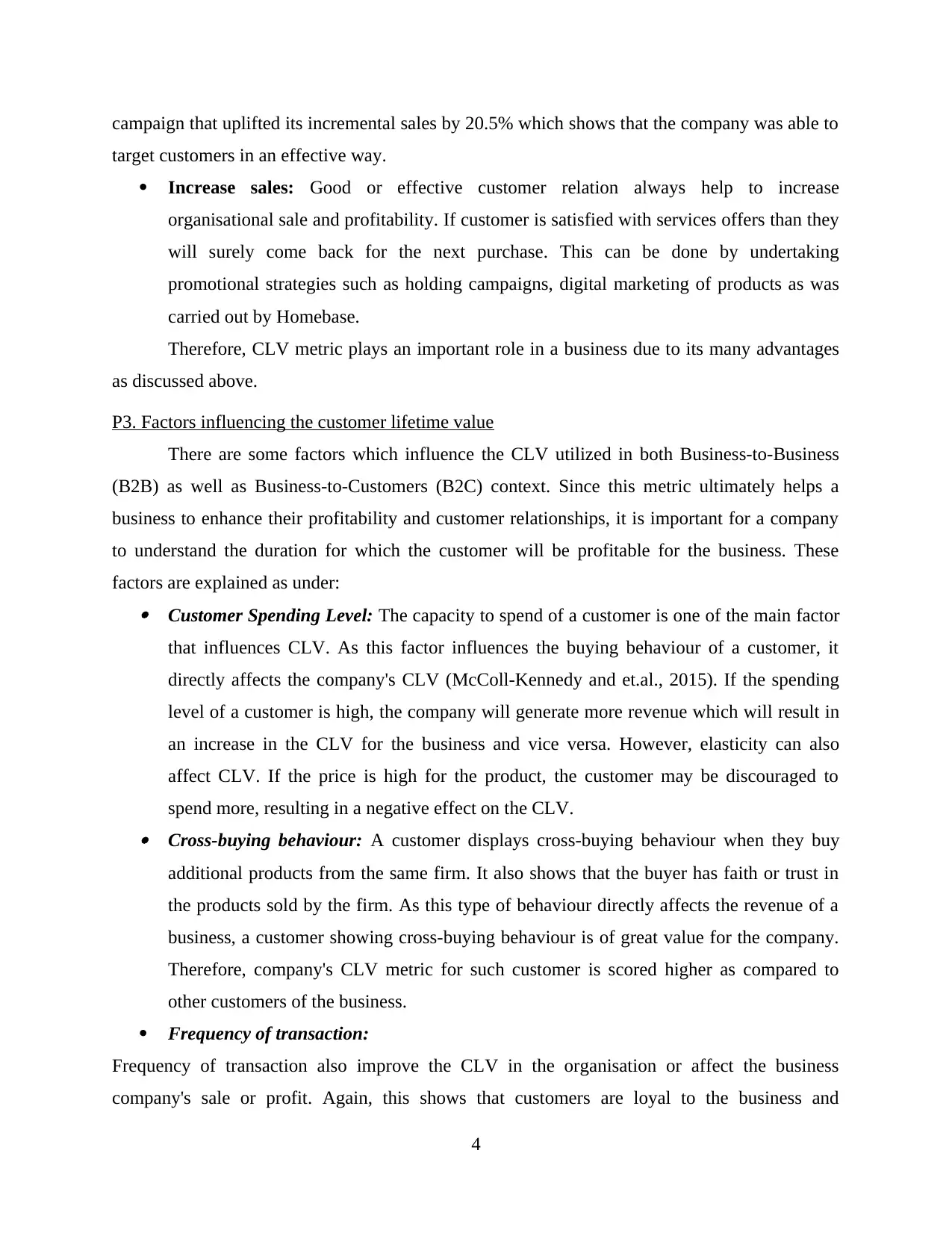
campaign that uplifted its incremental sales by 20.5% which shows that the company was able to
target customers in an effective way.
Increase sales: Good or effective customer relation always help to increase
organisational sale and profitability. If customer is satisfied with services offers than they
will surely come back for the next purchase. This can be done by undertaking
promotional strategies such as holding campaigns, digital marketing of products as was
carried out by Homebase.
Therefore, CLV metric plays an important role in a business due to its many advantages
as discussed above.
P3. Factors influencing the customer lifetime value
There are some factors which influence the CLV utilized in both Business-to-Business
(B2B) as well as Business-to-Customers (B2C) context. Since this metric ultimately helps a
business to enhance their profitability and customer relationships, it is important for a company
to understand the duration for which the customer will be profitable for the business. These
factors are explained as under: Customer Spending Level: The capacity to spend of a customer is one of the main factor
that influences CLV. As this factor influences the buying behaviour of a customer, it
directly affects the company's CLV (McColl-Kennedy and et.al., 2015). If the spending
level of a customer is high, the company will generate more revenue which will result in
an increase in the CLV for the business and vice versa. However, elasticity can also
affect CLV. If the price is high for the product, the customer may be discouraged to
spend more, resulting in a negative effect on the CLV. Cross-buying behaviour: A customer displays cross-buying behaviour when they buy
additional products from the same firm. It also shows that the buyer has faith or trust in
the products sold by the firm. As this type of behaviour directly affects the revenue of a
business, a customer showing cross-buying behaviour is of great value for the company.
Therefore, company's CLV metric for such customer is scored higher as compared to
other customers of the business.
Frequency of transaction:
Frequency of transaction also improve the CLV in the organisation or affect the business
company's sale or profit. Again, this shows that customers are loyal to the business and
4
target customers in an effective way.
Increase sales: Good or effective customer relation always help to increase
organisational sale and profitability. If customer is satisfied with services offers than they
will surely come back for the next purchase. This can be done by undertaking
promotional strategies such as holding campaigns, digital marketing of products as was
carried out by Homebase.
Therefore, CLV metric plays an important role in a business due to its many advantages
as discussed above.
P3. Factors influencing the customer lifetime value
There are some factors which influence the CLV utilized in both Business-to-Business
(B2B) as well as Business-to-Customers (B2C) context. Since this metric ultimately helps a
business to enhance their profitability and customer relationships, it is important for a company
to understand the duration for which the customer will be profitable for the business. These
factors are explained as under: Customer Spending Level: The capacity to spend of a customer is one of the main factor
that influences CLV. As this factor influences the buying behaviour of a customer, it
directly affects the company's CLV (McColl-Kennedy and et.al., 2015). If the spending
level of a customer is high, the company will generate more revenue which will result in
an increase in the CLV for the business and vice versa. However, elasticity can also
affect CLV. If the price is high for the product, the customer may be discouraged to
spend more, resulting in a negative effect on the CLV. Cross-buying behaviour: A customer displays cross-buying behaviour when they buy
additional products from the same firm. It also shows that the buyer has faith or trust in
the products sold by the firm. As this type of behaviour directly affects the revenue of a
business, a customer showing cross-buying behaviour is of great value for the company.
Therefore, company's CLV metric for such customer is scored higher as compared to
other customers of the business.
Frequency of transaction:
Frequency of transaction also improve the CLV in the organisation or affect the business
company's sale or profit. Again, this shows that customers are loyal to the business and
4
⊘ This is a preview!⊘
Do you want full access?
Subscribe today to unlock all pages.

Trusted by 1+ million students worldwide
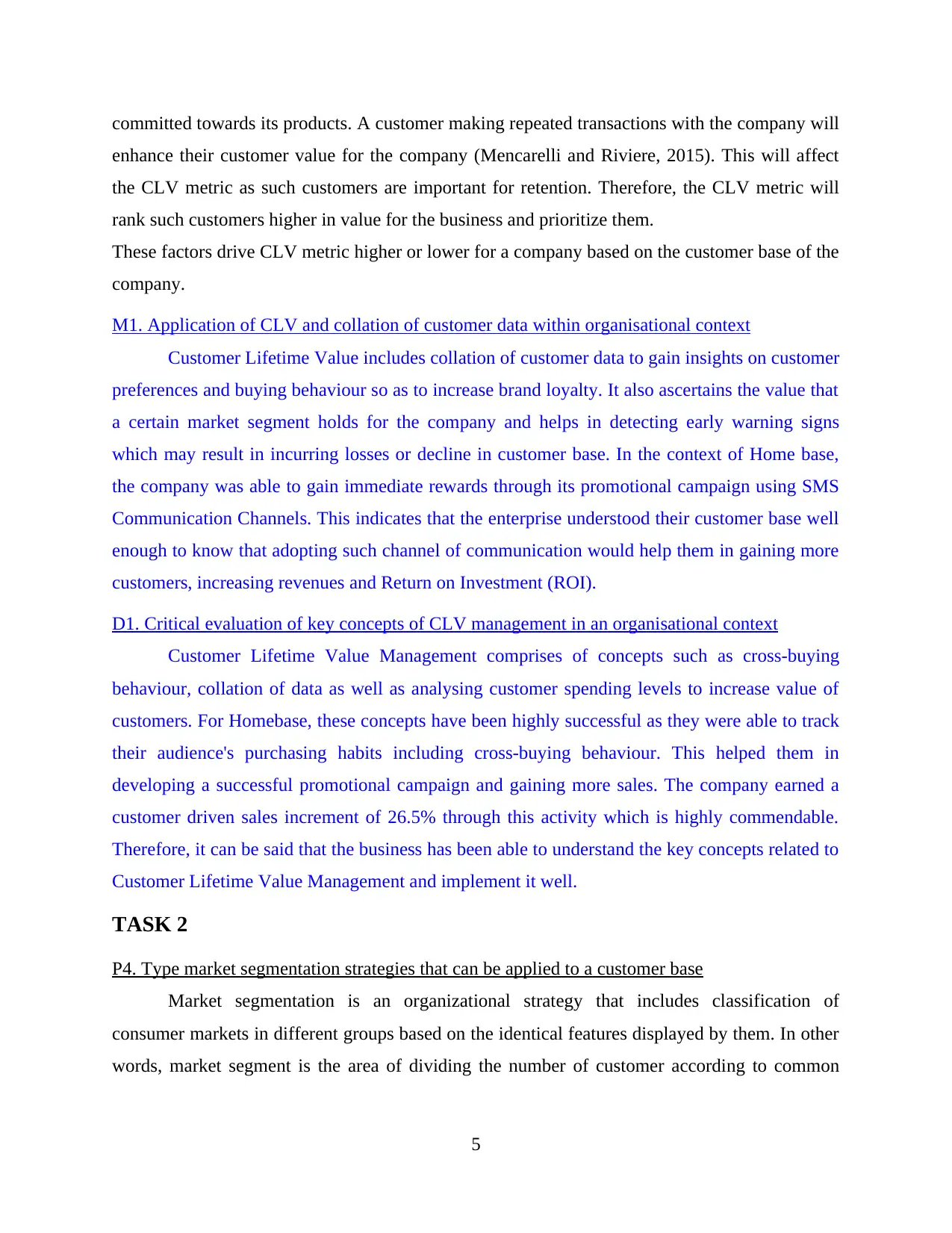
committed towards its products. A customer making repeated transactions with the company will
enhance their customer value for the company (Mencarelli and Riviere, 2015). This will affect
the CLV metric as such customers are important for retention. Therefore, the CLV metric will
rank such customers higher in value for the business and prioritize them.
These factors drive CLV metric higher or lower for a company based on the customer base of the
company.
M1. Application of CLV and collation of customer data within organisational context
Customer Lifetime Value includes collation of customer data to gain insights on customer
preferences and buying behaviour so as to increase brand loyalty. It also ascertains the value that
a certain market segment holds for the company and helps in detecting early warning signs
which may result in incurring losses or decline in customer base. In the context of Home base,
the company was able to gain immediate rewards through its promotional campaign using SMS
Communication Channels. This indicates that the enterprise understood their customer base well
enough to know that adopting such channel of communication would help them in gaining more
customers, increasing revenues and Return on Investment (ROI).
D1. Critical evaluation of key concepts of CLV management in an organisational context
Customer Lifetime Value Management comprises of concepts such as cross-buying
behaviour, collation of data as well as analysing customer spending levels to increase value of
customers. For Homebase, these concepts have been highly successful as they were able to track
their audience's purchasing habits including cross-buying behaviour. This helped them in
developing a successful promotional campaign and gaining more sales. The company earned a
customer driven sales increment of 26.5% through this activity which is highly commendable.
Therefore, it can be said that the business has been able to understand the key concepts related to
Customer Lifetime Value Management and implement it well.
TASK 2
P4. Type market segmentation strategies that can be applied to a customer base
Market segmentation is an organizational strategy that includes classification of
consumer markets in different groups based on the identical features displayed by them. In other
words, market segment is the area of dividing the number of customer according to common
5
enhance their customer value for the company (Mencarelli and Riviere, 2015). This will affect
the CLV metric as such customers are important for retention. Therefore, the CLV metric will
rank such customers higher in value for the business and prioritize them.
These factors drive CLV metric higher or lower for a company based on the customer base of the
company.
M1. Application of CLV and collation of customer data within organisational context
Customer Lifetime Value includes collation of customer data to gain insights on customer
preferences and buying behaviour so as to increase brand loyalty. It also ascertains the value that
a certain market segment holds for the company and helps in detecting early warning signs
which may result in incurring losses or decline in customer base. In the context of Home base,
the company was able to gain immediate rewards through its promotional campaign using SMS
Communication Channels. This indicates that the enterprise understood their customer base well
enough to know that adopting such channel of communication would help them in gaining more
customers, increasing revenues and Return on Investment (ROI).
D1. Critical evaluation of key concepts of CLV management in an organisational context
Customer Lifetime Value Management comprises of concepts such as cross-buying
behaviour, collation of data as well as analysing customer spending levels to increase value of
customers. For Homebase, these concepts have been highly successful as they were able to track
their audience's purchasing habits including cross-buying behaviour. This helped them in
developing a successful promotional campaign and gaining more sales. The company earned a
customer driven sales increment of 26.5% through this activity which is highly commendable.
Therefore, it can be said that the business has been able to understand the key concepts related to
Customer Lifetime Value Management and implement it well.
TASK 2
P4. Type market segmentation strategies that can be applied to a customer base
Market segmentation is an organizational strategy that includes classification of
consumer markets in different groups based on the identical features displayed by them. In other
words, market segment is the area of dividing the number of customer according to common
5
Paraphrase This Document
Need a fresh take? Get an instant paraphrase of this document with our AI Paraphraser
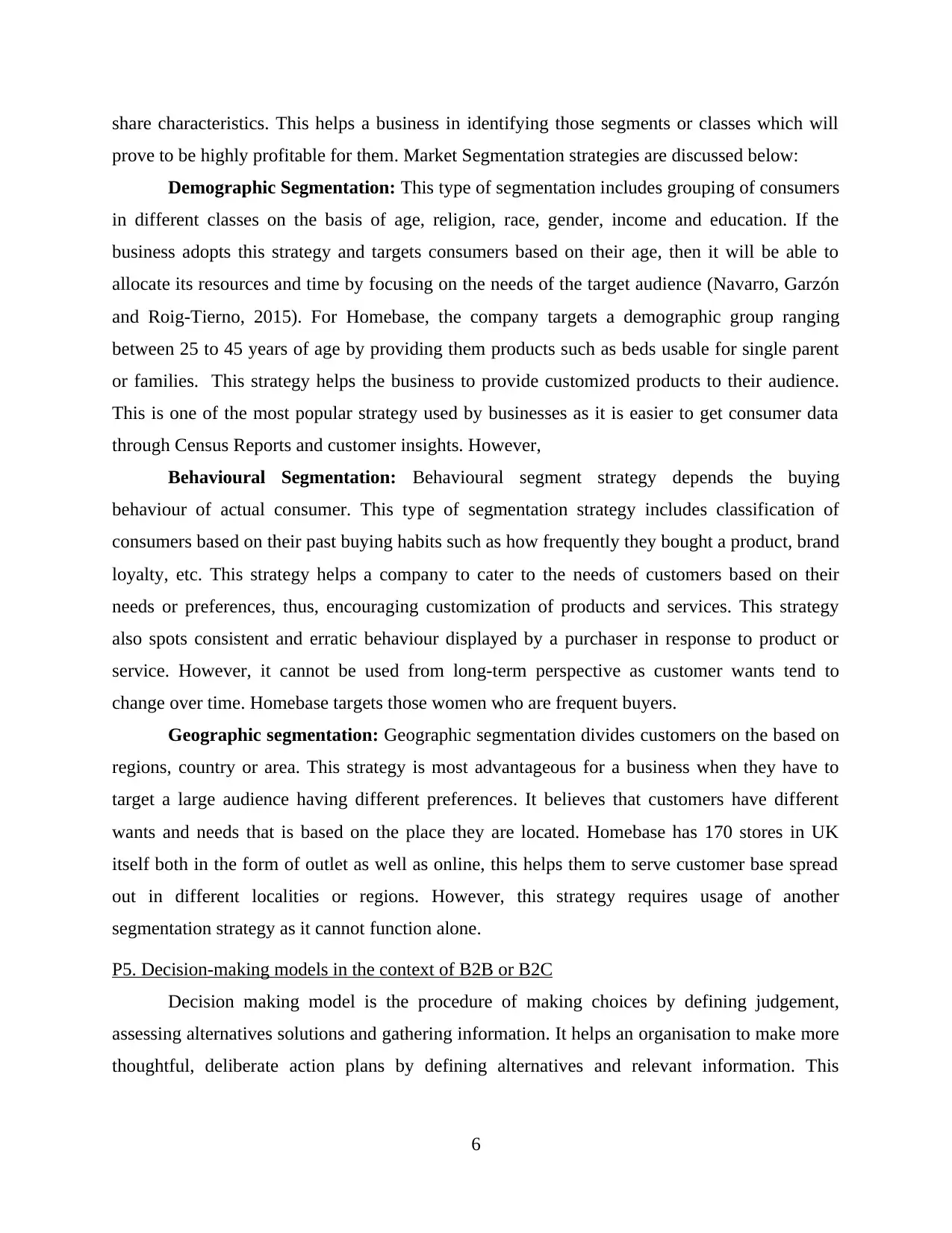
share characteristics. This helps a business in identifying those segments or classes which will
prove to be highly profitable for them. Market Segmentation strategies are discussed below:
Demographic Segmentation: This type of segmentation includes grouping of consumers
in different classes on the basis of age, religion, race, gender, income and education. If the
business adopts this strategy and targets consumers based on their age, then it will be able to
allocate its resources and time by focusing on the needs of the target audience (Navarro, Garzón
and Roig-Tierno, 2015). For Homebase, the company targets a demographic group ranging
between 25 to 45 years of age by providing them products such as beds usable for single parent
or families. This strategy helps the business to provide customized products to their audience.
This is one of the most popular strategy used by businesses as it is easier to get consumer data
through Census Reports and customer insights. However,
Behavioural Segmentation: Behavioural segment strategy depends the buying
behaviour of actual consumer. This type of segmentation strategy includes classification of
consumers based on their past buying habits such as how frequently they bought a product, brand
loyalty, etc. This strategy helps a company to cater to the needs of customers based on their
needs or preferences, thus, encouraging customization of products and services. This strategy
also spots consistent and erratic behaviour displayed by a purchaser in response to product or
service. However, it cannot be used from long-term perspective as customer wants tend to
change over time. Homebase targets those women who are frequent buyers.
Geographic segmentation: Geographic segmentation divides customers on the based on
regions, country or area. This strategy is most advantageous for a business when they have to
target a large audience having different preferences. It believes that customers have different
wants and needs that is based on the place they are located. Homebase has 170 stores in UK
itself both in the form of outlet as well as online, this helps them to serve customer base spread
out in different localities or regions. However, this strategy requires usage of another
segmentation strategy as it cannot function alone.
P5. Decision-making models in the context of B2B or B2C
Decision making model is the procedure of making choices by defining judgement,
assessing alternatives solutions and gathering information. It helps an organisation to make more
thoughtful, deliberate action plans by defining alternatives and relevant information. This
6
prove to be highly profitable for them. Market Segmentation strategies are discussed below:
Demographic Segmentation: This type of segmentation includes grouping of consumers
in different classes on the basis of age, religion, race, gender, income and education. If the
business adopts this strategy and targets consumers based on their age, then it will be able to
allocate its resources and time by focusing on the needs of the target audience (Navarro, Garzón
and Roig-Tierno, 2015). For Homebase, the company targets a demographic group ranging
between 25 to 45 years of age by providing them products such as beds usable for single parent
or families. This strategy helps the business to provide customized products to their audience.
This is one of the most popular strategy used by businesses as it is easier to get consumer data
through Census Reports and customer insights. However,
Behavioural Segmentation: Behavioural segment strategy depends the buying
behaviour of actual consumer. This type of segmentation strategy includes classification of
consumers based on their past buying habits such as how frequently they bought a product, brand
loyalty, etc. This strategy helps a company to cater to the needs of customers based on their
needs or preferences, thus, encouraging customization of products and services. This strategy
also spots consistent and erratic behaviour displayed by a purchaser in response to product or
service. However, it cannot be used from long-term perspective as customer wants tend to
change over time. Homebase targets those women who are frequent buyers.
Geographic segmentation: Geographic segmentation divides customers on the based on
regions, country or area. This strategy is most advantageous for a business when they have to
target a large audience having different preferences. It believes that customers have different
wants and needs that is based on the place they are located. Homebase has 170 stores in UK
itself both in the form of outlet as well as online, this helps them to serve customer base spread
out in different localities or regions. However, this strategy requires usage of another
segmentation strategy as it cannot function alone.
P5. Decision-making models in the context of B2B or B2C
Decision making model is the procedure of making choices by defining judgement,
assessing alternatives solutions and gathering information. It helps an organisation to make more
thoughtful, deliberate action plans by defining alternatives and relevant information. This
6
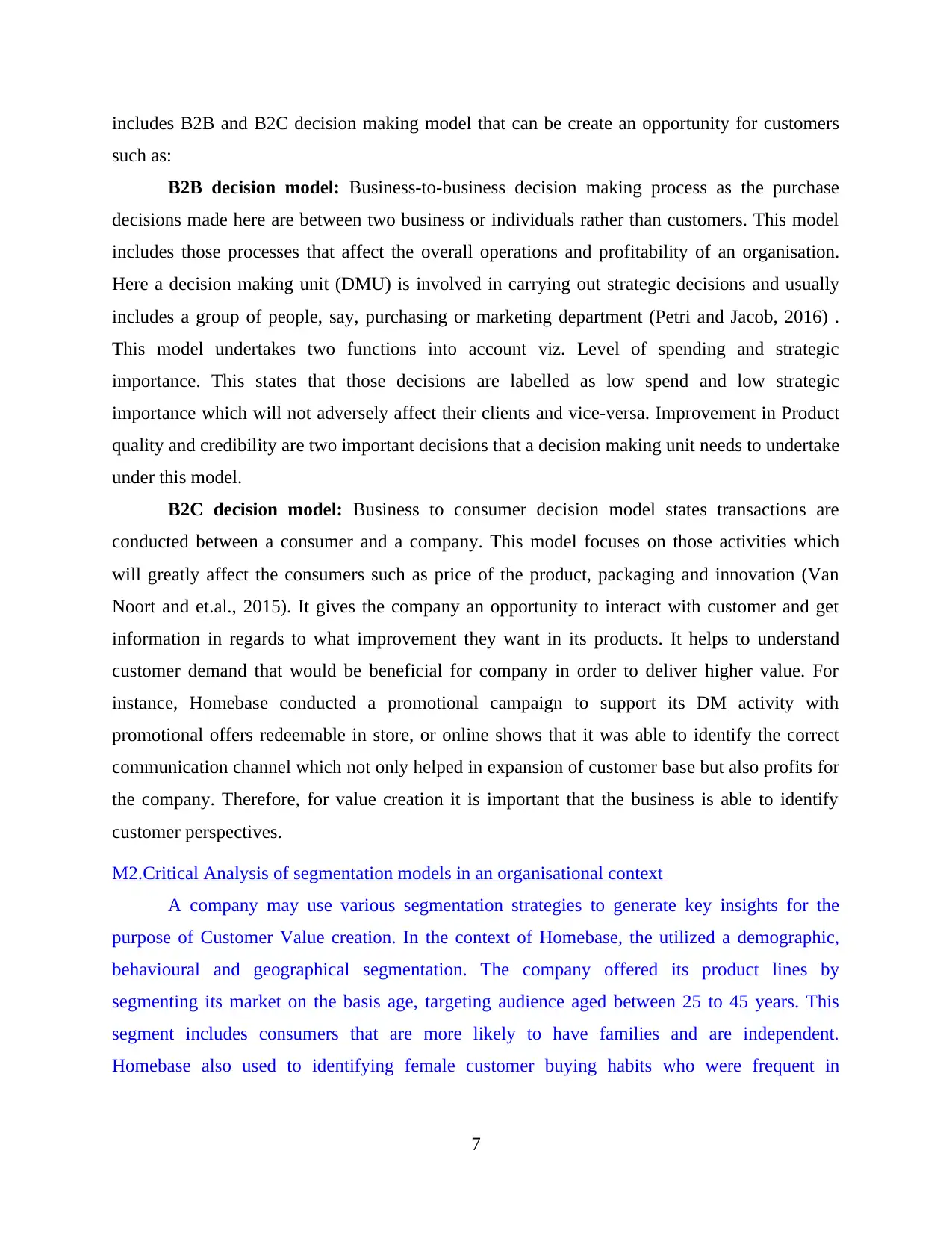
includes B2B and B2C decision making model that can be create an opportunity for customers
such as:
B2B decision model: Business-to-business decision making process as the purchase
decisions made here are between two business or individuals rather than customers. This model
includes those processes that affect the overall operations and profitability of an organisation.
Here a decision making unit (DMU) is involved in carrying out strategic decisions and usually
includes a group of people, say, purchasing or marketing department (Petri and Jacob, 2016) .
This model undertakes two functions into account viz. Level of spending and strategic
importance. This states that those decisions are labelled as low spend and low strategic
importance which will not adversely affect their clients and vice-versa. Improvement in Product
quality and credibility are two important decisions that a decision making unit needs to undertake
under this model.
B2C decision model: Business to consumer decision model states transactions are
conducted between a consumer and a company. This model focuses on those activities which
will greatly affect the consumers such as price of the product, packaging and innovation (Van
Noort and et.al., 2015). It gives the company an opportunity to interact with customer and get
information in regards to what improvement they want in its products. It helps to understand
customer demand that would be beneficial for company in order to deliver higher value. For
instance, Homebase conducted a promotional campaign to support its DM activity with
promotional offers redeemable in store, or online shows that it was able to identify the correct
communication channel which not only helped in expansion of customer base but also profits for
the company. Therefore, for value creation it is important that the business is able to identify
customer perspectives.
M2.Critical Analysis of segmentation models in an organisational context
A company may use various segmentation strategies to generate key insights for the
purpose of Customer Value creation. In the context of Homebase, the utilized a demographic,
behavioural and geographical segmentation. The company offered its product lines by
segmenting its market on the basis age, targeting audience aged between 25 to 45 years. This
segment includes consumers that are more likely to have families and are independent.
Homebase also used to identifying female customer buying habits who were frequent in
7
such as:
B2B decision model: Business-to-business decision making process as the purchase
decisions made here are between two business or individuals rather than customers. This model
includes those processes that affect the overall operations and profitability of an organisation.
Here a decision making unit (DMU) is involved in carrying out strategic decisions and usually
includes a group of people, say, purchasing or marketing department (Petri and Jacob, 2016) .
This model undertakes two functions into account viz. Level of spending and strategic
importance. This states that those decisions are labelled as low spend and low strategic
importance which will not adversely affect their clients and vice-versa. Improvement in Product
quality and credibility are two important decisions that a decision making unit needs to undertake
under this model.
B2C decision model: Business to consumer decision model states transactions are
conducted between a consumer and a company. This model focuses on those activities which
will greatly affect the consumers such as price of the product, packaging and innovation (Van
Noort and et.al., 2015). It gives the company an opportunity to interact with customer and get
information in regards to what improvement they want in its products. It helps to understand
customer demand that would be beneficial for company in order to deliver higher value. For
instance, Homebase conducted a promotional campaign to support its DM activity with
promotional offers redeemable in store, or online shows that it was able to identify the correct
communication channel which not only helped in expansion of customer base but also profits for
the company. Therefore, for value creation it is important that the business is able to identify
customer perspectives.
M2.Critical Analysis of segmentation models in an organisational context
A company may use various segmentation strategies to generate key insights for the
purpose of Customer Value creation. In the context of Homebase, the utilized a demographic,
behavioural and geographical segmentation. The company offered its product lines by
segmenting its market on the basis age, targeting audience aged between 25 to 45 years. This
segment includes consumers that are more likely to have families and are independent.
Homebase also used to identifying female customer buying habits who were frequent in
7
⊘ This is a preview!⊘
Do you want full access?
Subscribe today to unlock all pages.

Trusted by 1+ million students worldwide
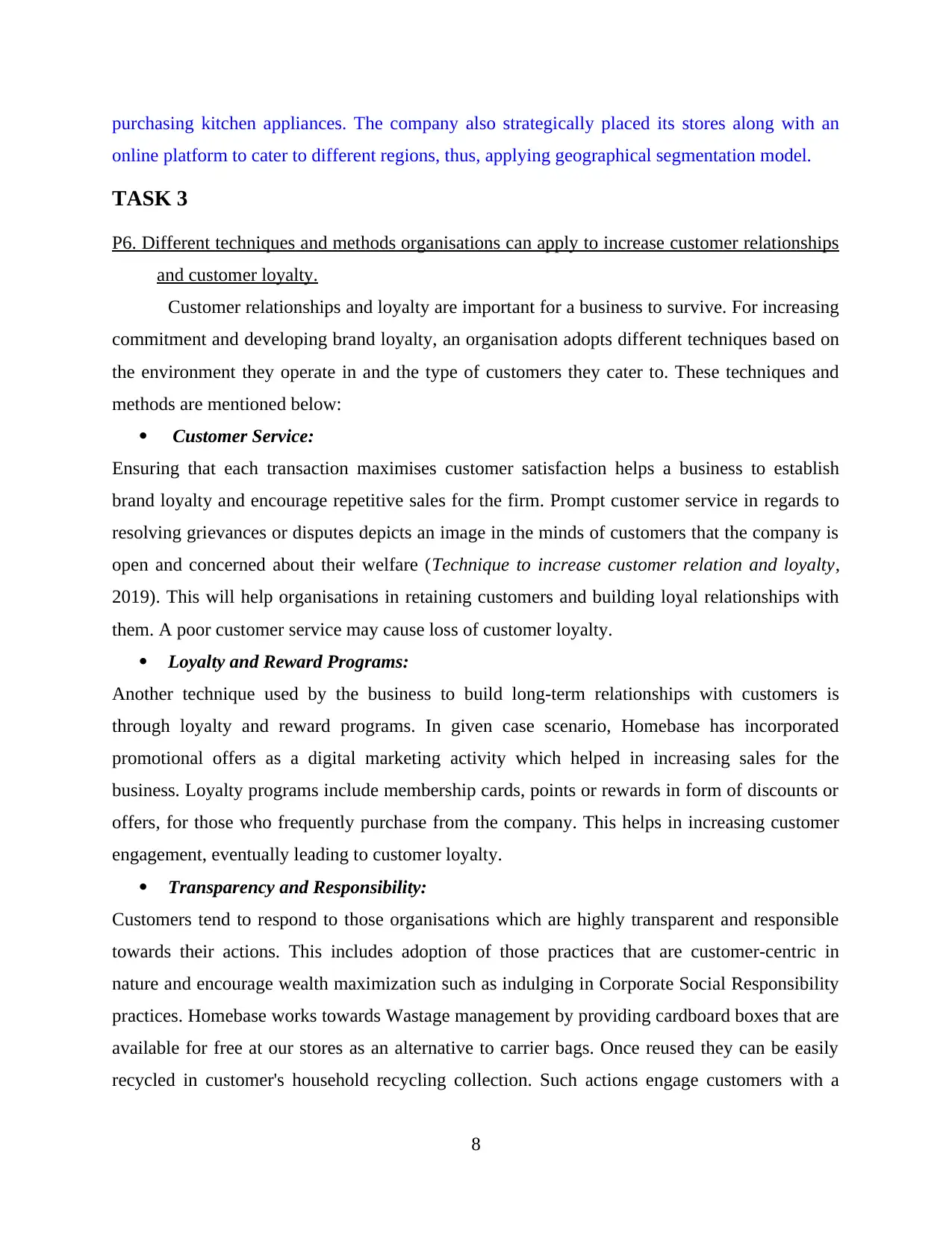
purchasing kitchen appliances. The company also strategically placed its stores along with an
online platform to cater to different regions, thus, applying geographical segmentation model.
TASK 3
P6. Different techniques and methods organisations can apply to increase customer relationships
and customer loyalty.
Customer relationships and loyalty are important for a business to survive. For increasing
commitment and developing brand loyalty, an organisation adopts different techniques based on
the environment they operate in and the type of customers they cater to. These techniques and
methods are mentioned below:
Customer Service:
Ensuring that each transaction maximises customer satisfaction helps a business to establish
brand loyalty and encourage repetitive sales for the firm. Prompt customer service in regards to
resolving grievances or disputes depicts an image in the minds of customers that the company is
open and concerned about their welfare (Technique to increase customer relation and loyalty,
2019). This will help organisations in retaining customers and building loyal relationships with
them. A poor customer service may cause loss of customer loyalty.
Loyalty and Reward Programs:
Another technique used by the business to build long-term relationships with customers is
through loyalty and reward programs. In given case scenario, Homebase has incorporated
promotional offers as a digital marketing activity which helped in increasing sales for the
business. Loyalty programs include membership cards, points or rewards in form of discounts or
offers, for those who frequently purchase from the company. This helps in increasing customer
engagement, eventually leading to customer loyalty.
Transparency and Responsibility:
Customers tend to respond to those organisations which are highly transparent and responsible
towards their actions. This includes adoption of those practices that are customer-centric in
nature and encourage wealth maximization such as indulging in Corporate Social Responsibility
practices. Homebase works towards Wastage management by providing cardboard boxes that are
available for free at our stores as an alternative to carrier bags. Once reused they can be easily
recycled in customer's household recycling collection. Such actions engage customers with a
8
online platform to cater to different regions, thus, applying geographical segmentation model.
TASK 3
P6. Different techniques and methods organisations can apply to increase customer relationships
and customer loyalty.
Customer relationships and loyalty are important for a business to survive. For increasing
commitment and developing brand loyalty, an organisation adopts different techniques based on
the environment they operate in and the type of customers they cater to. These techniques and
methods are mentioned below:
Customer Service:
Ensuring that each transaction maximises customer satisfaction helps a business to establish
brand loyalty and encourage repetitive sales for the firm. Prompt customer service in regards to
resolving grievances or disputes depicts an image in the minds of customers that the company is
open and concerned about their welfare (Technique to increase customer relation and loyalty,
2019). This will help organisations in retaining customers and building loyal relationships with
them. A poor customer service may cause loss of customer loyalty.
Loyalty and Reward Programs:
Another technique used by the business to build long-term relationships with customers is
through loyalty and reward programs. In given case scenario, Homebase has incorporated
promotional offers as a digital marketing activity which helped in increasing sales for the
business. Loyalty programs include membership cards, points or rewards in form of discounts or
offers, for those who frequently purchase from the company. This helps in increasing customer
engagement, eventually leading to customer loyalty.
Transparency and Responsibility:
Customers tend to respond to those organisations which are highly transparent and responsible
towards their actions. This includes adoption of those practices that are customer-centric in
nature and encourage wealth maximization such as indulging in Corporate Social Responsibility
practices. Homebase works towards Wastage management by providing cardboard boxes that are
available for free at our stores as an alternative to carrier bags. Once reused they can be easily
recycled in customer's household recycling collection. Such actions engage customers with a
8
Paraphrase This Document
Need a fresh take? Get an instant paraphrase of this document with our AI Paraphraser
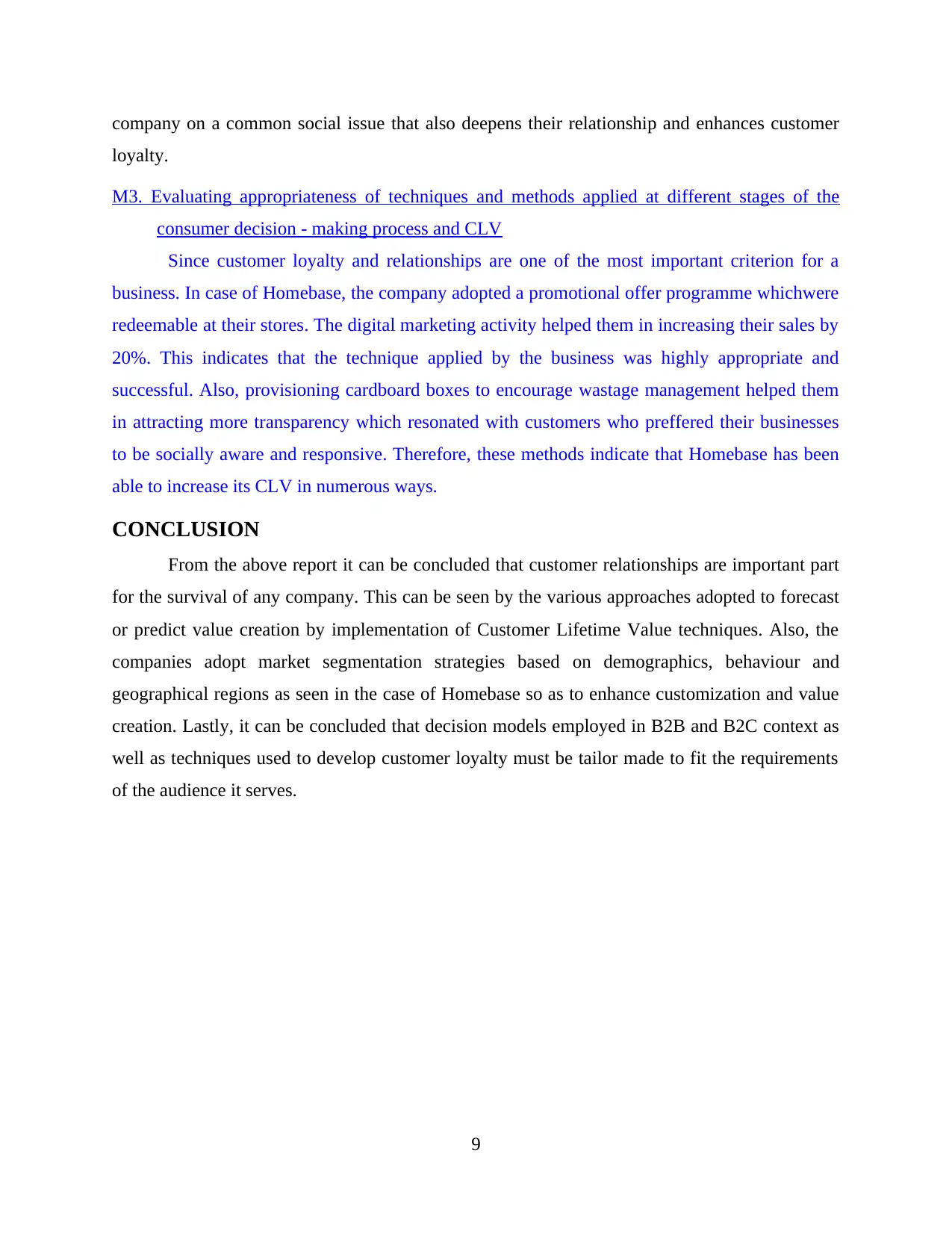
company on a common social issue that also deepens their relationship and enhances customer
loyalty.
M3. Evaluating appropriateness of techniques and methods applied at different stages of the
consumer decision - making process and CLV
Since customer loyalty and relationships are one of the most important criterion for a
business. In case of Homebase, the company adopted a promotional offer programme whichwere
redeemable at their stores. The digital marketing activity helped them in increasing their sales by
20%. This indicates that the technique applied by the business was highly appropriate and
successful. Also, provisioning cardboard boxes to encourage wastage management helped them
in attracting more transparency which resonated with customers who preffered their businesses
to be socially aware and responsive. Therefore, these methods indicate that Homebase has been
able to increase its CLV in numerous ways.
CONCLUSION
From the above report it can be concluded that customer relationships are important part
for the survival of any company. This can be seen by the various approaches adopted to forecast
or predict value creation by implementation of Customer Lifetime Value techniques. Also, the
companies adopt market segmentation strategies based on demographics, behaviour and
geographical regions as seen in the case of Homebase so as to enhance customization and value
creation. Lastly, it can be concluded that decision models employed in B2B and B2C context as
well as techniques used to develop customer loyalty must be tailor made to fit the requirements
of the audience it serves.
9
loyalty.
M3. Evaluating appropriateness of techniques and methods applied at different stages of the
consumer decision - making process and CLV
Since customer loyalty and relationships are one of the most important criterion for a
business. In case of Homebase, the company adopted a promotional offer programme whichwere
redeemable at their stores. The digital marketing activity helped them in increasing their sales by
20%. This indicates that the technique applied by the business was highly appropriate and
successful. Also, provisioning cardboard boxes to encourage wastage management helped them
in attracting more transparency which resonated with customers who preffered their businesses
to be socially aware and responsive. Therefore, these methods indicate that Homebase has been
able to increase its CLV in numerous ways.
CONCLUSION
From the above report it can be concluded that customer relationships are important part
for the survival of any company. This can be seen by the various approaches adopted to forecast
or predict value creation by implementation of Customer Lifetime Value techniques. Also, the
companies adopt market segmentation strategies based on demographics, behaviour and
geographical regions as seen in the case of Homebase so as to enhance customization and value
creation. Lastly, it can be concluded that decision models employed in B2B and B2C context as
well as techniques used to develop customer loyalty must be tailor made to fit the requirements
of the audience it serves.
9
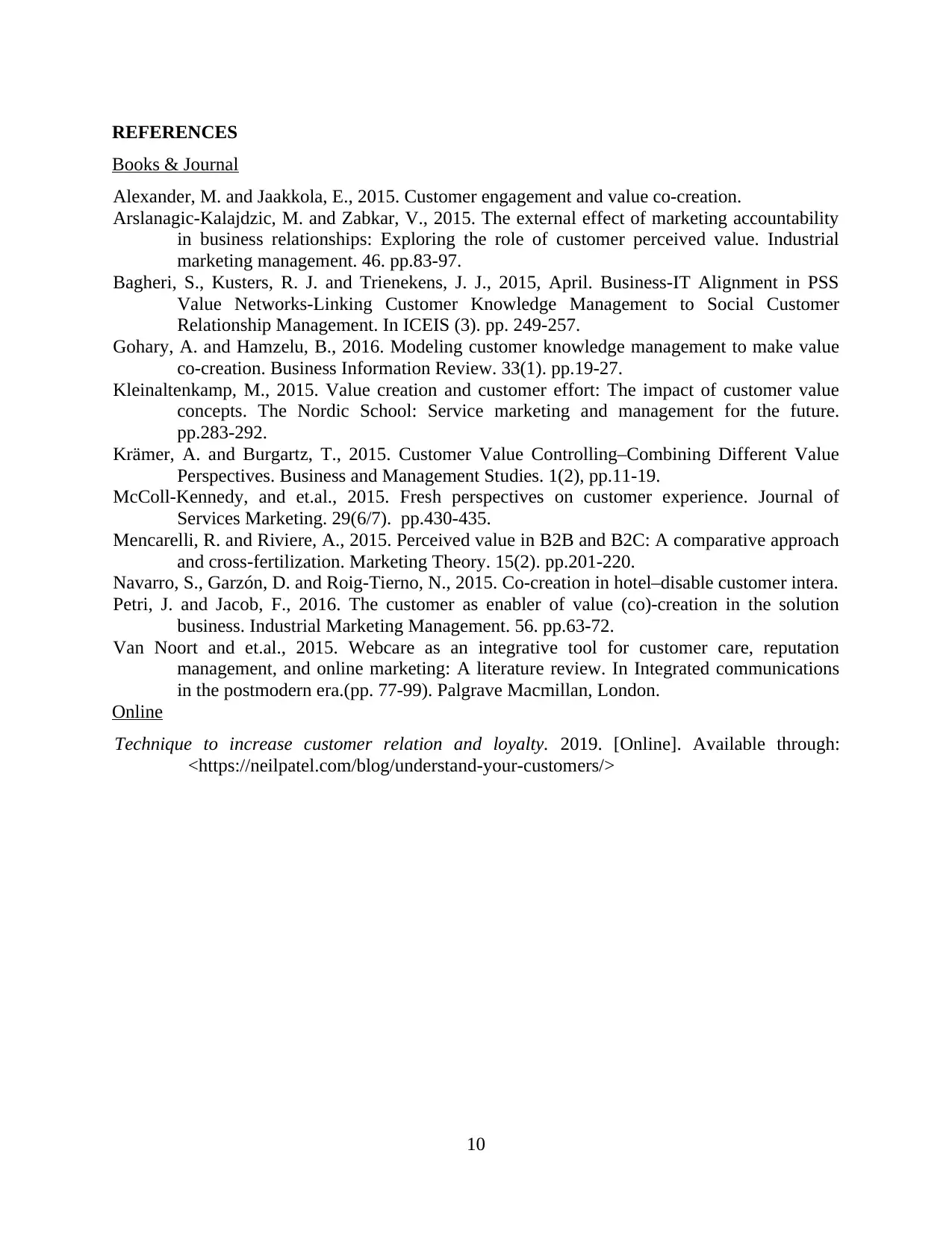
REFERENCES
Books & Journal
Alexander, M. and Jaakkola, E., 2015. Customer engagement and value co-creation.
Arslanagic-Kalajdzic, M. and Zabkar, V., 2015. The external effect of marketing accountability
in business relationships: Exploring the role of customer perceived value. Industrial
marketing management. 46. pp.83-97.
Bagheri, S., Kusters, R. J. and Trienekens, J. J., 2015, April. Business-IT Alignment in PSS
Value Networks-Linking Customer Knowledge Management to Social Customer
Relationship Management. In ICEIS (3). pp. 249-257.
Gohary, A. and Hamzelu, B., 2016. Modeling customer knowledge management to make value
co-creation. Business Information Review. 33(1). pp.19-27.
Kleinaltenkamp, M., 2015. Value creation and customer effort: The impact of customer value
concepts. The Nordic School: Service marketing and management for the future.
pp.283-292.
Krämer, A. and Burgartz, T., 2015. Customer Value Controlling–Combining Different Value
Perspectives. Business and Management Studies. 1(2), pp.11-19.
McColl-Kennedy, and et.al., 2015. Fresh perspectives on customer experience. Journal of
Services Marketing. 29(6/7). pp.430-435.
Mencarelli, R. and Riviere, A., 2015. Perceived value in B2B and B2C: A comparative approach
and cross-fertilization. Marketing Theory. 15(2). pp.201-220.
Navarro, S., Garzón, D. and Roig-Tierno, N., 2015. Co-creation in hotel–disable customer intera.
Petri, J. and Jacob, F., 2016. The customer as enabler of value (co)-creation in the solution
business. Industrial Marketing Management. 56. pp.63-72.
Van Noort and et.al., 2015. Webcare as an integrative tool for customer care, reputation
management, and online marketing: A literature review. In Integrated communications
in the postmodern era.(pp. 77-99). Palgrave Macmillan, London.
Online
Technique to increase customer relation and loyalty. 2019. [Online]. Available through:
<https://neilpatel.com/blog/understand-your-customers/>
10
Books & Journal
Alexander, M. and Jaakkola, E., 2015. Customer engagement and value co-creation.
Arslanagic-Kalajdzic, M. and Zabkar, V., 2015. The external effect of marketing accountability
in business relationships: Exploring the role of customer perceived value. Industrial
marketing management. 46. pp.83-97.
Bagheri, S., Kusters, R. J. and Trienekens, J. J., 2015, April. Business-IT Alignment in PSS
Value Networks-Linking Customer Knowledge Management to Social Customer
Relationship Management. In ICEIS (3). pp. 249-257.
Gohary, A. and Hamzelu, B., 2016. Modeling customer knowledge management to make value
co-creation. Business Information Review. 33(1). pp.19-27.
Kleinaltenkamp, M., 2015. Value creation and customer effort: The impact of customer value
concepts. The Nordic School: Service marketing and management for the future.
pp.283-292.
Krämer, A. and Burgartz, T., 2015. Customer Value Controlling–Combining Different Value
Perspectives. Business and Management Studies. 1(2), pp.11-19.
McColl-Kennedy, and et.al., 2015. Fresh perspectives on customer experience. Journal of
Services Marketing. 29(6/7). pp.430-435.
Mencarelli, R. and Riviere, A., 2015. Perceived value in B2B and B2C: A comparative approach
and cross-fertilization. Marketing Theory. 15(2). pp.201-220.
Navarro, S., Garzón, D. and Roig-Tierno, N., 2015. Co-creation in hotel–disable customer intera.
Petri, J. and Jacob, F., 2016. The customer as enabler of value (co)-creation in the solution
business. Industrial Marketing Management. 56. pp.63-72.
Van Noort and et.al., 2015. Webcare as an integrative tool for customer care, reputation
management, and online marketing: A literature review. In Integrated communications
in the postmodern era.(pp. 77-99). Palgrave Macmillan, London.
Online
Technique to increase customer relation and loyalty. 2019. [Online]. Available through:
<https://neilpatel.com/blog/understand-your-customers/>
10
⊘ This is a preview!⊘
Do you want full access?
Subscribe today to unlock all pages.

Trusted by 1+ million students worldwide
1 out of 12
Related Documents
Your All-in-One AI-Powered Toolkit for Academic Success.
+13062052269
info@desklib.com
Available 24*7 on WhatsApp / Email
![[object Object]](/_next/static/media/star-bottom.7253800d.svg)
Unlock your academic potential
Copyright © 2020–2025 A2Z Services. All Rights Reserved. Developed and managed by ZUCOL.





